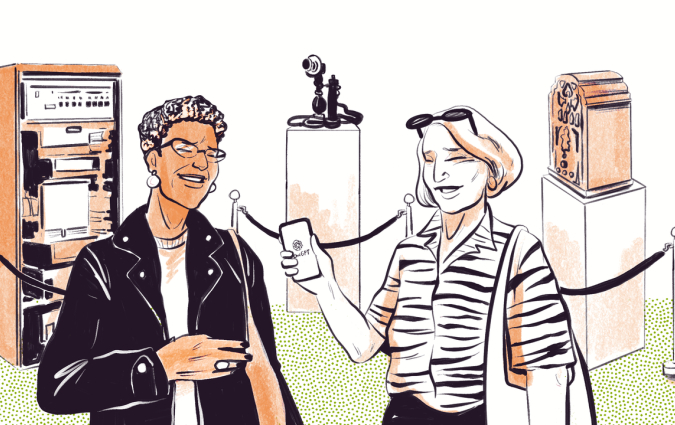To report fully on climate change, journalists need to integrate Indigenous knowledge into their coverage

Rex Holwell, 47, rides a skidoo during a weekly run to test sea thickness towards Nain Bay, a popular fishing spot for community members in Nain, Newfoundland and Labrador, Canada, April 21, 2022. Credit: Melissa Renwick/Reuters
“The ice is forming, but not like it should—it’s close to a month late,” Joey Angnatok told me in early January last year.
That conversation, and others that followed, became the focus of a story I wrote in April 2022 on weakening sea ice in the far North of Canada.
The story recounts the work of Angnatok, an Inuit fishing captain from Nain, the northernmost community on the Labrador coast in eastern Canada, whose work combines traditional Inuit knowledge with scientific process.
Reporting this story taught me that journalists covering climate change can offer a much fuller picture of its impacts by working closely with Indigenous sources and drawing on both Indigenous knowledge and Western science.
It also taught me that we can't depend solely on numbers and data to compel readers to care. Without drawing on Indigenous perspectives, we miss out on reporting on the real toll of climate change and understanding ways communities are tackling it.
Inuit are an Indigenous circumpolar people who live in the North. Sea ice travel is central to Inuit identity, culture and livelihood, and doing so safely relies on knowledge passed down orally over generations from Elders and shared among community members through day-to-day observations and lived experiences.
Angnatok is as comfortable relying on a traditional harpoon or hunting spear as he is a modern ice sensor to gauge ice conditions. He also has extensive knowledge about the types and forms of ice, how ice changes in relation to its environment (for example, ocean tides or snow coverage) and what happens to the condition of the ice throughout the seasons and across regions.
As a non-Indigenous fisheries and oceans reporter in Canada, I had previously reported on the warming trend in the Northwest Atlantic Ocean, where ice has been weakening and ocean temperatures have been rising since the mid-1990s. The three warmest years on record have occurred in the last decade in the Northwest Atlantic, and the Arctic is warming nearly four times faster than the rest of the world, according to a paper published in August 2022.
While climate data captures the magnitude of the warming trend, it falls short of explaining what’s happening on the ice, much less in a way that incorporates Indigenous knowledge and the impacts on those communities.
When I interviewed Angnatok, he worried that a slow start to the sea ice season might signal yet another unusually warm year in Inuit Nunangat, the Inuit homelands, which comprise 50% of Canada’s coastline—the largest on the planet.
In remote northern communities, ice is an extension of the land, connecting communities to one another and the goods and services on which they depend. At best, poor ice conditions are inconvenient, disrupting travel and access to hunting grounds and firewood. At worst, weak ice cuts off supply lines by choking off a community’s ability to transport goods over solid ground. Flying in goods is costly and frequently disrupted by bad weather.
And yet, the views of those who actually live in the North tend to be lacking in news coverage—and the reporting gap is often wider for Indigenous viewpoints than non-Indigenous ones.
That applies to fisheries, too. News coverage usually concentrates on the federal government’s management of commercially valuable fish populations. But beyond commercial value, fish and fishing are about feeding families, and have social and ceremonial purposes in Indigenous communities. In Nain, an everyday fishing trip isn’t about profit—it’s about putting a good meal on the table.
This encapsulates the guiding principle of Two-Eyed Seeing. Developed by Mi'kmaw Elder Albert Marshall in 2004, Two-Eyed Seeing refers to “learning to see from one eye with the strengths of Indigenous knowledges and ways of knowing, and from the other eye with the strengths of Western knowledges and ways of knowing… and learning to use both these eyes together, for the benefit of all.” Intended for research where different cultures learn together, Two-Eyed seeing can be useful in other fields, such as journalism.
As a white settler, I’m dependent on Indigenous sources for climate coverage that lends Two-Eyed Seeing perspectives. There also needs to be more Indigenous reporters covering Indigenous stories. In Canada, this is part of a broader shift already taking place in research to recognise and ensure that Indigenous people have control over their own data-collection processes, and how this evidence is used.
Angnatok's role as a sea captain-turned-citizen scientist also offers a prime example of this push. The Inuit Tapiriit Kanatami (ITK)—the national representative organization for the over 65,000 Inuit in Canada—also calls for this in its National Inuit Climate Change Strategy: that Inuit must lead conversations about climate change, rather than be seen as passive victims of a changing environment.
Ultimately, without understanding and including Indigenous perspectives in climate reporting, we lose significant insights about climate change—from ways to tackle it, to the toll on humans and nature.





